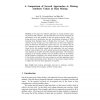Free Online Productivity Tools
i2Speak
i2Symbol
i2OCR
iTex2Img
iWeb2Print
iWeb2Shot
i2Type
iPdf2Split
iPdf2Merge
i2Bopomofo
i2Arabic
i2Style
i2Image
i2PDF
iLatex2Rtf
Sci2ools
RSCTC
2000
Springer
2000
Springer
A Comparison of Several Approaches to Missing Attribute Values in Data Mining
: In the paper nine different approaches to missing attribute values are presented and compared. Ten input data files were used to investigate the performance of the nine methods to deal with missing attribute values. For testing both naive classification and new classification techniques of LERS (Learning from Examples based on Rough Sets) were used. The quality criterion was the average error rate achieved by ten-fold cross-validation. Using the Wilcoxon matched-pairs signed rank test, we conclude that the C4.5 approach and the method of ignoring examples with missing attribute values are the best methods among all nine approaches; the most common attribute-value method is the worst method among all nine approaches; while some methods do not differ from other methods significantly. The method of assigning to the missing attribute value all possible values of the attribute and the method of assigning to the missing attribute value all possible values of the attribute restricted to the...
Common Attribute-value Method | Fuzzy Logic | Missing Attribute Value | Possible Values | RSCTC 2000 |
Related Content
| Added | 25 Aug 2010 |
| Updated | 25 Aug 2010 |
| Type | Conference |
| Year | 2000 |
| Where | RSCTC |
| Authors | Jerzy W. Grzymala-Busse, Ming Hu |
Comments (0)

